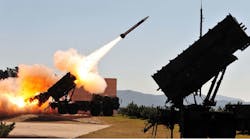Improving the accuracy and precision of weapons systems is always of interest to designers of defense systems, and BAE Systems attracted a great deal of attention at the recent Air Force Association (AFA) Air Warfare Symposium in Orlando, Fla.
BAE offered insight into the benefits of the laser-based guidance technology used in its Advanced Precision Kill Weapon System (APKWS). The guidance system is designed to lock onto targets from more than 3 km away, enabling aircraft and laser designators to maintain a safe distance from enemy threats. With improved accuracy, the danger of collateral damage from a missile striking off course is also decreased.
An APKWS rocket (Fig. 1) has advanced distributed aperture semi-active laser seeker (DASALS) optics on all four guidance wings. Once the rocket is fired, the optical electronics are energized and guide the rocket to a designated target with high accuracy. The optical electronics are protected by seals against damage from the environment (such as sand and moisture) and from adjacent rocket/missile firings from a launch vehicle.
1. Laser-based APKWS guidance kits provide high accuracy for rocket strikes from either rotary- or fixed-wing aircraft at stationary or moving targets. (Photo courtesy of BAE Systems)
The accuracy of the DASALS optical system is such that rockets have achieved greater than 93% accuracy when fired from rotary- and fixed-wing aircraft. In fact, this optical technology is part of the U.S. Government’s only program of record for 2.75-in. (70-mm) laser-guided rockets.
The high-performance optical technology enables a rocket to lock onto moving or stationary targets, whether in open or confined areas. The precision of the optical guidance function minimize the possibility of a lost or uncontrolled rocket after launch. The DASALS technology provides a 40-deg. instantaneous field of targeting for the rocket, giving it the capability to adjust its trajectory as needed in midflight to find its target.
2. BAE is prepared to produce more than 20,000 APKWS laser-based missile guidance kits from a dedicated New Hampshire facility. (Photo courtesy of BAE Systems)
APKWS rockets have been successfully deployed in support of U.S. Army combat operations in Iraq and Afghanistan, and have been fired from more than 20 different rotary- and fixed-wing aircraft. The technology is being used by the U.S. Army, Navy, Air Force, and Marines. It is cost-effective compared to other missile guidance systems, with a modular design approach that lends itself to high-volume manufacturing of APKWS guidance kits as needed for delivery.
In fact, the company is equipped to produce more than 20,000 of these APKWS guidance kits per year by means of a dedicated facility in New Hampshire (Fig. 2). It expects to continue expanding production as the demand for the missile guidance technology increases.



